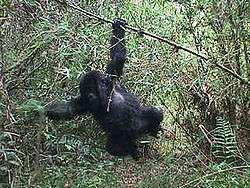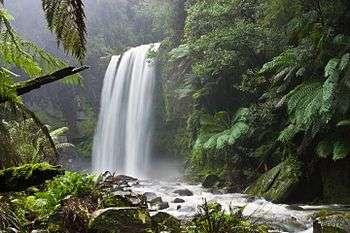Conservation in Uganda
Conservation in Uganda is the protection and sustainable use of the country's rich natural resources. It became a significant movement during the British colonial period in the early 20th century and continues to play a major role in Uganda's political economy, as it underpins the tourist industry accounting for a fifth of the country's exports.[1]
Uganda's 60 conservation protected areas harbor populations of numerous critically endangered species.
History of conservation
British Protectorate (1894-1962)
Active concerted management of wildlife in the Uganda Protectorate began in 1923 with the formation of the Elephant Control Department. The object of this organization was to reduce the damage to peasant agriculture by limiting the size and range of elephant populations. Culling programs killed an average of 1000 elephants per year.[2]
International agencies
Wildlife Conservation Society

In 2015, the published results of the "Great Elephant Census", an aerial survey undertaken by the WCS along with the UWA, indicated that the number of African bush elephants has increased by almost 600 percent from a low of 700 to 800 individuals in the 1980s up to 5,000 individuals. The survey was conducted in Queen Elizabeth National Park (2,913 elephants), Murchison Falls National Park (1,330 elephants), and Kidepo Valley National Park (656 elephants). The survey did not include protected areas with elephant populations like Kibale National Park, Rwenzori Mountains National Park, Semliki National Park, and the Toro-Semliki Wildlife Reserve as well as closed canopy areas like the Maramagambo forest within Queen Elizabeth National Park and the Kaniyo Pabidi forest within Murchison Falls National Park.[3]
Wildlife
Uganda is home to a vast number of species, including a population of mountain gorillas in the Bwindi Impenetrable National Park, gorillas and golden monkeys in the Mgahinga Gorilla National Park, and hippos in the Murchison Falls National Park.[4]
See also
- List of Protected Areas in Uganda
- National Cultural Sites of Uganda
Notes
- World Bank 2011.
- Meredith 2001, p. 126.
- "Uganda's elephant population on the rise - Africa Geographic". 29 May 2015.
- Watching Wildlife: East Africa, Kenya, Tanzania, Uganda, Rwanda. Lonely Planet. 2009.
References
- Meredith, Martin (2009-04-27). Elephant Destiny: Biography of an Endangered Species in Africa. PublicAffairs. ISBN 9780786728381.
- Wildlife Conservation Society (2012). "Uganda". Archived from the original on 2009-02-07. Retrieved 2012-08-05.
- International Trade Centre (2011). "Trade Map". Retrieved 2012-08-05.
Further reading
- James Kalema; Henk Beentje. (2012). Conservation checklist of the trees of Uganda. Richmond, Surrey, UK : Kew Pub. ISBN 9781842463772

